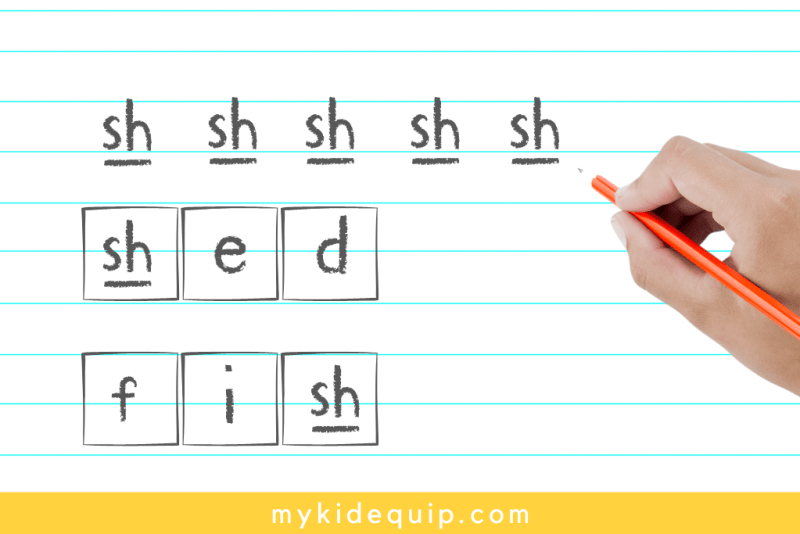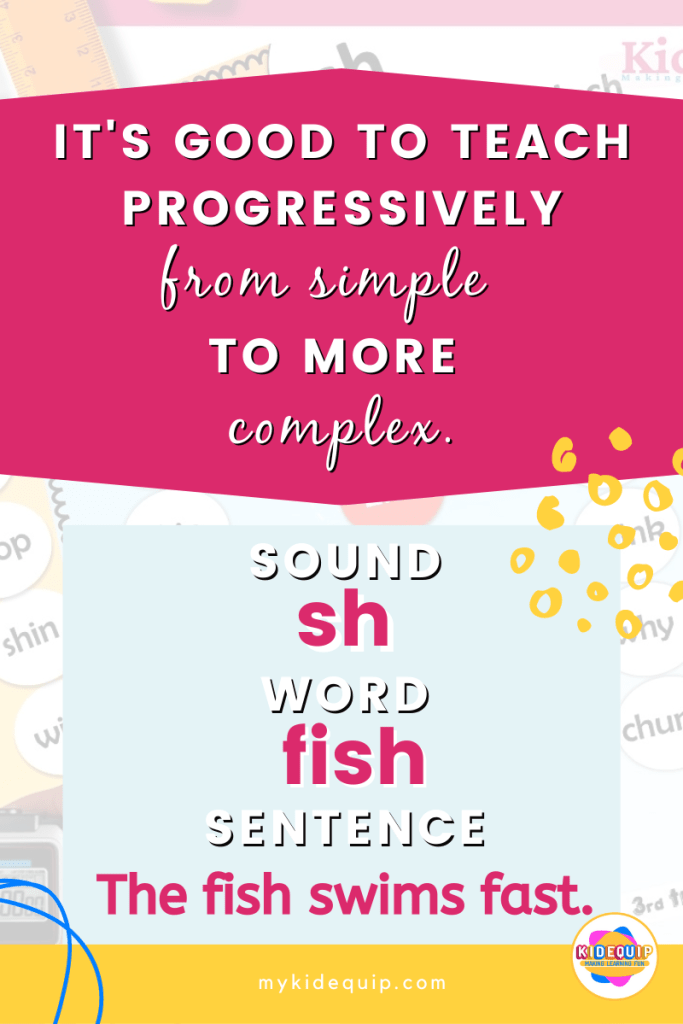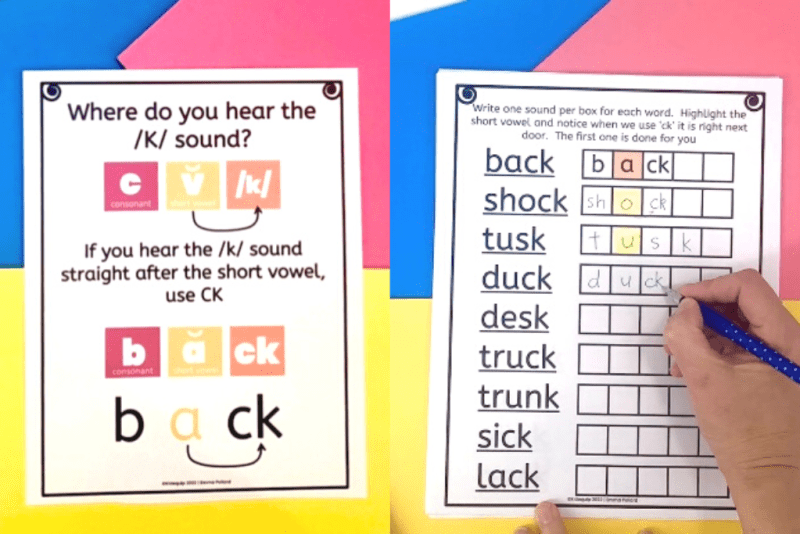What are consonant digraphs?
Consonant digraphs are when two letters combine to make one sound. They are the very next skill I teach after letter sounds and short vowel sounds.
The most common consonant digraph examples are sh, ch, th, and wh. These are the digraphs that I would introduce first. Children need to be able to see that two letters are combining to make one sound.

How to teach consonant digraphs.
As with all phonics skills, we need to first introduce the sound. I will read out a list of words that have the same sound and ask them what phoneme (sound) they can hear at the beginning or end of the words.
For example:- ship sheep sham or fish wish mash
If this is too hard for them, I will just give them two words and tell them to listen to the beginning sound. I would use some form of physical manipulative for this such as counters, playdough, or lego.
For example, I will say, ” Listen to the sounds at the beginning of these two words.” As I say the words, I will touch or push up a counter for each sound. See the image below. There are two words for each separate digraph being introduced. Note: I would only introduce one sound per lesson.

Once a child can hear the consonant digraph sound, you can then explicilty show them how that sound is made with two letters. Then you can practice hearing the sound at the end of words, such as fish, wish, posh, hush, gash.
Next, I would get the child to write down the digraph ‘sh’ across the page, saying the sound each time they write it. Progressing on from there to words and then sentences.


5 Consonant Digraphs I would start with:-
Below are the 5 consonant digraphs that are the easiest to introduce. Only introduce these sounds once a child is confident with their individual consonant sounds.
- sh
- ch
- th (unvoiced as in ‘think’ and voiced as in ‘this’)
- wh (predominantly used for question words)
- ph (less common – greek origin words such as ‘photo’ and ‘alphabet’)
When introducing ‘wh’, I will point out that the most common way to spell the /w/ sound is with ‘w’ but that the most common way to spell question words is with ‘wh’. I also don’t spend a long time on ‘ph’ as it is a lot less common.
3 consonant digraphs and trigraphs to introduce next:-
The next 3 consonant digraphs each follow a spelling rule that is important to teach. It is the same pattern for each which is why I will often introduce them one after the other.
- ck ( two letters making one sound.)
- tch ( three letters making one sound – a trigraph)
- dge ( three letters making one sound – a trigraph)
These spellings are used at the end of one-syllable words straight after a short vowel. I will get my students to ask themselves these 3 questions.
- 1. Does this word have 1 syllable?
- 2. Does this word end with a /k/, /j/ or /ch/ sound?
- 3. Is there a short vowel sound right before it?
If they can answer yes to those 3 questions they know to use the digraph or trigraph spelling above. I will also often show them a video from ‘Nessy Youtube’ which explains it in a fun way. Check out one of those videos here.
Below is an example of a consonant digraph activity that I have found very helpful to introduce and practice these spelling rules. Notice that there are words where the digraph ‘ck’ is not used. Children soon recognise the pattern of the short vowel coming straight before the /k/ sound. This really helps to cement this digraph spelling and it becomes automatic.
Teaching phoneme-grapheme relationships
It is very important to remember when teaching phoneme-grapheme relationships that the teaching needs to be explicit and there needs to be lots of opportunities for review ( more than you would expect).
Below are some of the ways that I help children to review consonant digraphs:-
Phoneme-Grapheme Flashcards
I use phoneme-grapheme visual drill cards at the beginning of every structured literacy lesson.
These can be physical or digital representations and the goal is that when the child sees the grapheme, they can automatically give you the sound for that grapheme.
Some graphemes have more than one sound and so the complexity can increase as they learn.

Nonsense words
Using nonsense words with consonant digraphs and trigraphs helps children to really attend to the sounds in words. I use word cards with these nonsense words included to play games for review.
Below you can see a game of tic tac toe or noughts and crosses where children need to read the word to show which square they choose for their counter.
Word Mapping or Orthographic Mapping
Orthographic mapping is a powerful way to practice writing these words. I give my student a word and then ask them to count the sounds. They will then draw one box for each sound and write one sound per box.
Remember that a digraph or trigraph is only one sound so it goes into one box.
I have made word mapping activity sheets within my consonant digraph resources that you can find at the end of this blog post.

Dictation Sentences
This is where you can really see and assess how well your child/student has grasped the concept you have taught them.
It is a powerful way to help to consolidate these phoneme-grapheme relationships. Include words with previously taught graphemes and digraphs into dictation sentences.
It is always important to progress from reading (decoding) consonant digraph words to spelling (encoding) words with consonant digraphs and trigraphs.
Here are a few dictation sentences you can use with consonant digraphs:-
The man can catch fish with his rod.
She had the wish to go on a big ship.
I like to have chips and chops.
The dog will snatch my chops and chomp on them.
She can catch big fish with her rod.
Can I have a wedge of fresh fudge?
The duck got stuck on a wet rock.
Make sure to only use graphemes and irregular words (such as ‘the’), that have been explicitly taught.
Word Level Phonics Games
Another thing I like to do after teaching consonant digraphs during a lesson or for something fun to send home is to play a word-level game. Take a look at these fun ‘snakes and ladders’ type games I made for this reason.
Lastly, I want to clear up any confusion you may have between blends and digraphs.
What’s the difference between blends and digraphs?
Before I wrap up, and now that you know exactly what digraphs are, it is easier to know the difference between consonant blends and digraphs. Blends are two consonants together that both still retain their individual sounds.
For example, the word ‘flop’ has 4 sounds f – l – o – p. The two consonants before the short vowel sound are called consonant blends.
There are different opinions on whether to teach each consonant blend separately, but my opinion is, that if a child has learned consonant sounds there is no reason to have individual, explicit lessons for each consonant blend.
The only exception to this is for the consonant blends ‘tr’ ‘str‘ and ‘dr’, as these sounds are very hard to hear separately. They sound more like ‘chr’ ‘schr’ and ‘jr’. These two blends I will explicitly teach and review. You can see a more in-depth explanation on my Instagram @kidequipnz Click on the image below to learn more.
I also explain a little more in this video about how to help children that really struggle to hear the second sound in a consonant blend. Take a look below.
You can find all of the resources mentioned in this post at my TPT store ‘Kidequip’. Click on any image below to take a look. My aim is to arm you with fun and effective tools to really take your students to the next level in their decoding abilities.
Also, don’t forget to grab your free download at the end of this post. Happy learning!
Grab your free guide below
If you have a struggling reader who is not progressing and you are concerned that they may have a learning difficulty such as dyslexia, please download my free step-by-step guide below to help you answer some questions and hopefully get you on the way to finding the right help for your child.
Let’s Connect
I always am so happy to hear from people who have found this blog post helpful. Please reach out to me here or come and follow along with me on Instagram @kidequipnz
https://www.instagram.com/kidequipnz/























